India’s Third Gender and Visual Politics
By Sami Siva
Abstract
Despite the Government of India’s official recognition of “third gender” in 2014, the right to gender self-determination remains contested. Over one million transgender women in the country face discrimination and continue to live on the fringes of society. Discrimination and stigma force them to resort to prostitution, begging on city streets, and performing at village festivals. While transgender women are venerated during religious rituals and festivals, they are excluded from employment and higher education. This article outlines the cultural and social conditions facing the trans community in India, as well as the illiberal attitudes of society toward it, through the prism of visual analysis.
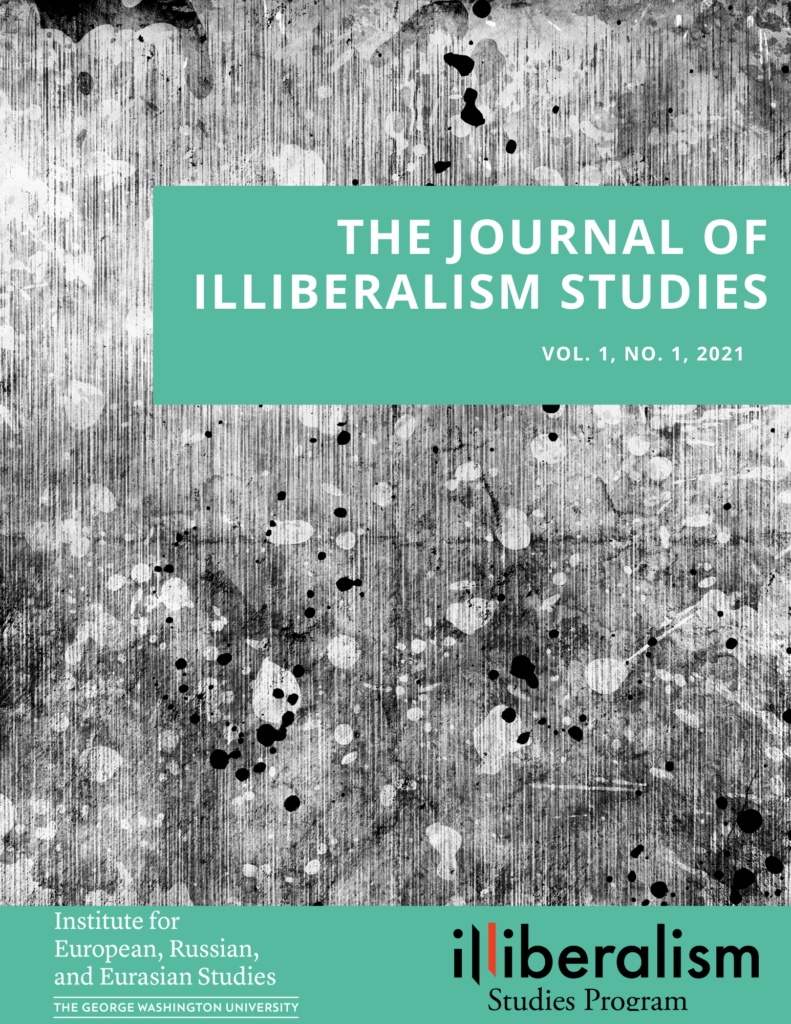
Siva, Sami. “India’s Third Gender and Visual Politics.” Journal of Illiberalism Studies 1, no. 1 (2021): 89-96 https://doi.org/10.53483/VCHX2528
Keywords: Transgender rights, gender identity, autonomy, marginalization
India, the largest democracy in the world, continues to struggle with societal stigmas related to moral values, and especially to sexual orientation. The life of the LGBT community is hampered by both the society’s conservative values and the legacy of British colonial legislation.[1] In recent years, rights groups have been able to influence the Indian legal system toward recognition of a “third gender,” but social attitudes toward the LGBT community, and especially transgender women, remain negative, even if the latter have played a role in Indian culture for millennia. In this article, I show how photography can be used to document social practices that are seen as both sacred and immoral. In this way, I hope to make a modest contribution to the “visual turn” in political science.
Mythology, Traditions, and Social Conditions
The existence of transgender women in India is not new. Reference to trans women can be found in the ancient Hindu scripture Mahabharata, which serves as the philosophical foundation of current Indian society. During the eighteen-day battle of Kurukshetra, Prince Aravan, son of Arjuna, decided to sacrifice himself to secure the victory of Pandavas. His last wish before dying on the battlefield was to get married. When no woman came forward to marry him, Krishna (one of many deities in Hinduism) transformed himself into a woman, Mohini, in order to fulfill Prince Aravan’s wish.[2] In Kama Sutra, the oldest known book on desire and sex, which dates back to the third century CE, cross-dressing and gay men are referred to as persons of “third nature” (tritiya prakriti). As explained by Doniger, “There are two sorts of third nature, in the form of a woman and in the form of a man. The one in the form of a woman imitates a woman’s dress, chatter, grace, emotions, delicacy, timidity, innocence, frailty and bashfulness”and makes a living as a courtesan.[3]
In the spring of each year, thousands of trans women gather in Koovagamvillage, about 120 kilometers south of Chennai (Madras), to reenact the wedding of Mohini and Aravan as portrayed in Mahabharata. During the festival, priests of the local temple perform a symbolic ritual wedding by giving them thali—the sacred thread traditionally tied around a woman’s neck during the Hindu wedding ceremony in Tamil Nadu. The following day, transgender women shun their symbolic thali and mourn the death of Aravan.[4] Such religious festivals and symbolic rituals allow transgender woman to foster community, maintain traditions, and preserve their identities.[5] Like the rest of Indian society, the transgender community has a hierarchical social structure. Across the country, there are several clans. Each clan is headed by a nayak (supreme leader); each community within the clan has a guru (master); and under each guru there are a number of chelas (disciples).
Traditionally, trans women earned their living by “blessing newborn babies and newlywed couples” and by “dancing in festivals and marriage ceremonies.”[6] The decline in such traditional practices has forced them to take up begging and sex work; one study concluded that about 62% of trans women are sex workers.[7] Those who attempt to seek regular employment face discrimination and stigma in the workplace regardless of their educational qualifications.[8]
For instance, during a trip to Koovagam on a reporting assignment in 2014, I met Tamil, a 20-year-old transgender woman who relies on sex work to make a living. Social stigma and marginalization had all but barred her from traditional employment and left her no choice but to resort to sex work and occasional performances at village festivals and funerals. Her guru,Rangeela, a college-educated 36-year-old, likewise suffered discrimination at her former workplace, which eventually led her to quit the job. She now works for an NGO that helps the MSM (“men who have sex with men”—a term used to identify male homosexuality) and transgender community in her town.For Tamil and her friends, identifying themselves as women is more important than the physical and psychological pain they endure. The men who have relationships with them or engage them for one-time sex allow them to assert their gender identity.[9] A year after our first meeting, Tamil eloped with her boyfriend; they now live together in their hometown. She has since stopped working as a sex worker.
The Legal Struggle for Recognition
Although transgender women are mentioned in India’s key cultural texts, their legal recognition in modern law has followed a complex trajectory. Like many other countries with a colonial past, India inherited laws that deem homosexuality a criminal offence.[10] The legal battle between LGBT activists and the Indian government began in 2001, when NAZ Foundation, a New Delhi-based organization working on issues related to HIV and sexuality, filed a public interest lawsuit with the Delhi High Court to repeal Section 377 on sodomy.[11] The colonial-era anti-sodomy law, introduced by the British Empire in 1860, criminalized sexual encounters between men as “unnatural offences.” The law stated, “Whoever voluntarily has carnal intercourse against the order of nature with any man, woman or animal shall be punished with imprisonment for life, or with imprisonment for a term which may extend to 10 years, and shall be liable to fine.”[12]
In 2009, the Delhi High Court decriminalized unconventional sex—an act that had previously been condemned as an “unnatural offence”[13]—as practiced by the lesbian, gay, bisexual, and transgender community. However, the Supreme Court of India overturned this move in 2013.[14] The decision left the transgender community vulnerable to harassment and criminal prosecution, as many of them depend on commercial sex work to make a living.
The legal struggle between rights groups and the government took a new turn in 2014, when a historic Supreme Court ruling ruled “that gender identity is integral to the dignity of an individual and is at the core of ‘personal autonomy’ and ‘self-determination’”[15] and recognized transgender as a “third gender,” thereby upholding individuals’ constitutional right to self-identify their gender as male, female or transgender.[16] This was a first step toward legally recognizing the transgender population and including them in the national census. Concurrently, through this judgment, transgender individuals gained the right to education and reservations in public jobs.[17]
Rights activists and the transgender community continued to fight for recognition, which led to the introduction to the parliament in 2016 of the Transgender Persons Bill. The bill came under intense criticism, as it had a series of flaws; most importantly, it did not address the right of transgender individuals to “self-determine their gender identity.”[18] Rights activists argued that legal reform needed to fully recognize transgender persons as citizens, as this would enable them to obtain the legal documents required for higher education, employment, and access to social services.[19] In 2017, the constitution bench of the Supreme Court of India ruled that “sexual orientation is an essential attribute of privacy,” a fundamental right guaranteed by the constitution. This decision, which is considered to bring Indian law in line with the international legal framework,[20] paved the way for reversing the 2013 judgment that had re-criminalized LGBT sexual activity. Nonetheless, members of the transgender community continue to be stigmatized and face discrimination on account of their gender identity.[21]
Following this new step in recognition, the Transgender Persons Bill was modified and reintroduced in 2019. The Transgender Persons (Protection of Rights) Act came into effect in 2020.[22] It ensured the inclusion of transgender people in government-issued documents by providing additional gender options—Transgender or Other—and kicked off the transgender rights movement in India. For Supreme Court lawyer and transgender rights activist Jayna Kothari, “The right to self-determination of gender identity” is fundamental to bodily integrity.[23] She argues that the medical model of identifying a person’s gender is “faulty,” as some trans women are reluctant to undergo either hormonal therapy or costly medical procedures. Judith Butler likewise notes the importance of self-identification: “trans sexuality is not a disorder, and ought not to be conceived of as one […] trans people ought to be understood as engaged in a practice of self-determination, an exercise of autonomy.”[24]
The current Hindu nationalist government’s policies—the repeal of Jammu’s and Kashmir’s semi-autonomous status; the enforcement of the Citizen Amendment Law, which left millions of people without citizenship of any country; and the suppression of students, academics, and journalists—serve to demonstrate that the country is taking an illiberal turn.[25] Through the prism of visual politics, a developing subfield in political science research, this article looks at the case of the transgender community in India and its struggle to gain equal rights in a deeply traditional society.
Visual Politics: The Body, Sacred and Immoral
Here I aim to explore ways in which photography can contribute to political science research. As Susan Sontag noted in her seminal work On Photography, “Through photographs, the world becomes a series of unrelated, free-standing particles; and history, past and present, a set of anecdotes and faits divers.”[26] Photography has been used to record all walks of life, from intimate personal moments to events that are of public interest. It serves as a tool to communicate information as diverse as news of war and crime, societal trends, and family heritage by offering direct access to the real. Photographs do not merely narrate something; they preserve appearances and memories.[27] These temporal instances then help to construct meanings, a process in which the photographer is both a participant and a witness.
Photography provides a “toolkit” for conducting ethnographic research. Photographs serve as an aide-mémoire by providing visual documentation. The trend toward visual communication via both traditional media and online social media has also created demand for photo documentation.[28] Photographs can be supportive as well as supplemental in social science research. This method is analogous to the “grounded theory” approach, in which social research is constructed through iterative evidence obtained from the field.[29] The images collected through photo documentation can be presented, following Saussure’s studies on “signs” and “systems,” as a discursive text.[30] Furthermore, as Roland Bleiker notes, the sensible nature of political issues can be studied through visuality, which falls under what he calls the “aesthetic turn” in social sciences.[31]
Social Practices and Representation
Rituals and complex socio-cultural practices are best explained through visual representations. Societal acceptance of transgender women as a sacred embodiment of Krishna is represented during the annual festival through rituals that are visually elaborative and performative. Whereas society normally discriminates against trans women because of their chosen identity, during this religious festival they are celebrated as the divine avatar of the gods.[32] Visual methods offer alternative ways of explaining situations, revealing, for instance, the magnitude of the ritual reenactment of the ceremonial wedding between Mohini (the transgender avatar of Krishna) and Aravan.
Figure 1. Aravan, the deity of the local temple, is celebrated during the Koovagam festival
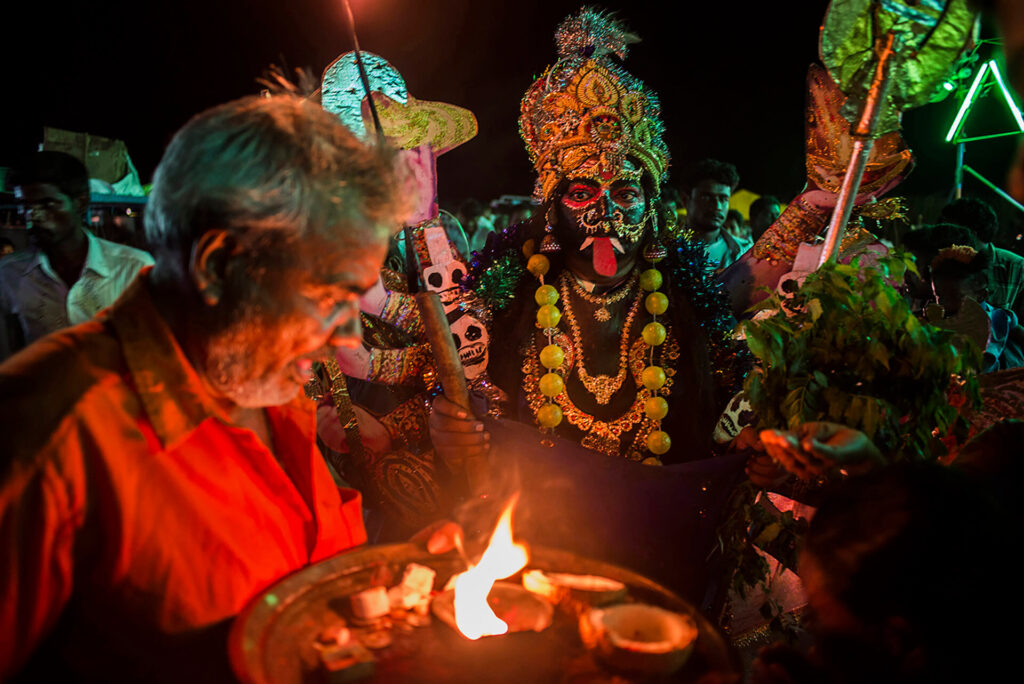
Source: Photo taken by the author, 2014.
Figure 2. Rangeela, 36, with the sacred thread that symbolizes her ceremonial wedding to the temple deity, Aravan

Source: Photo taken by the author, 2014.
Body as a Political Object
In the context of transgender rights in India, one of the key points of discussion is bodily transformation as opposed to self-identification as a woman (in the case of male-to-female transformation). In this way, the body has become the center of the legal debate over the social rights with which the transgender community is endowed. This idea of body as a political concept is in line with Giorgio Agamben’s study on “Sovereign Body and Scared Body.”[33]
As noted above, for Kothari, “the right to life also includes the right to bodily integrity,” meaning that the individual should decide their own gender identity rather than having it determined by a “medical model” that requires them to undergo certain procedures to be identified as female.[34] During my interviews, however, many transgender women expressed a strong desire to represent their femininity through physical, emotional, and visual transformations. The self-prescribed hormones, removal of genitals through medical or ritual methods, and new clothes complete their transformation and allow them to take on the identity of a woman.[35] Thus, the idea of suffering “‘for’ something, or ‘because’ of something” applies not only to images of war, but also to those of changed “socio-political and ideological” circumstances.[36] I argue that photographs of trans women’s bodies—whether dressed up during beauty pageants or naked, revealing their scars and anatomical differences—support the viewer’s understanding of the struggle and joy they experience during their physical and psychological transformation.
Figure 3. Contestants in a transgender beauty pageant during the annual festival in Koovagam
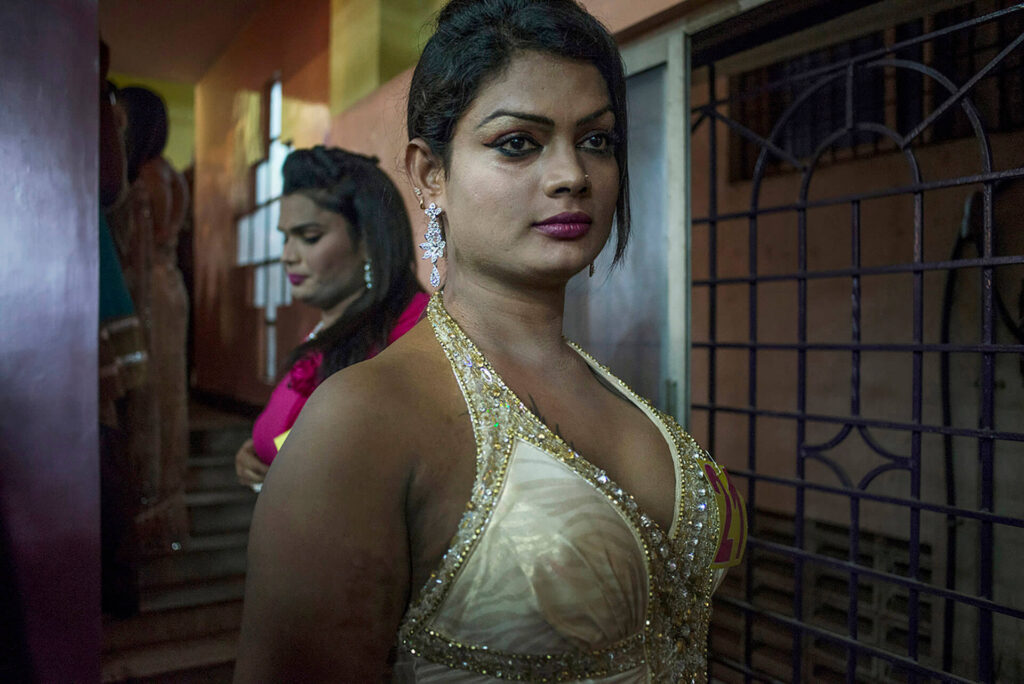
Source: Photo taken by the author, 2014.
Figure 4. Tamil, 20, went through the ritual of genital removal during her transformation process
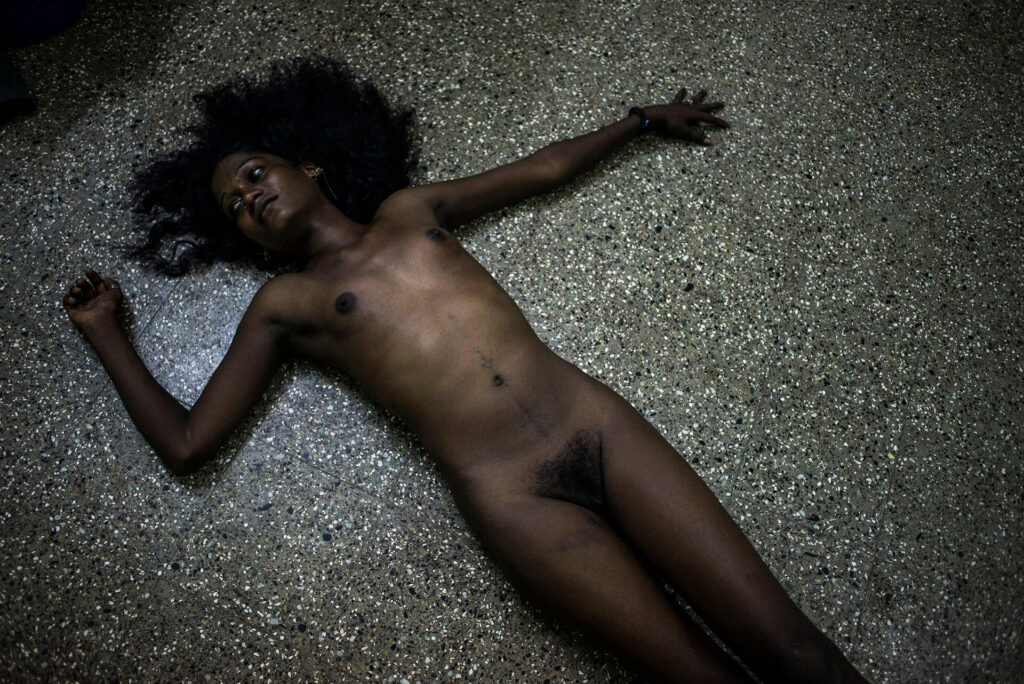
Source: Photo taken by the author, 2014.
Exceptionality and Visual Representation
The social exclusion and stigma faced by the transgender community on a daily basis dissipates during the Koovagam religious festival. At the pinnacle of the festival, people from all walks of life seek blessings from trans women, and at night, sex work is solicited on street corners and in open fields. Both Section 377 of the Indian Penal Code and the Immoral Traffic (Prevention) Act (ITPA) of 1956 criminalize the sex work performed by the trans community.[37] During the festival, however, the public conduct of commercial sex is tolerated by the local police and society alike. The bodies of the marginalized trans community are accepted into the society on the understanding that this is an exceptional situation. As Linda Åhäll puts it, “It is about how silences, gaps and invisibility are produced through what is either ‘seen’ or ‘not seen’. It is about how gendered bodies intersect with other visual identity markers, such as class, race, age and disability.”[38]
Figure 5. Chaya Singh and her friends solicit sex work during the Koovagam festival in Villupuram
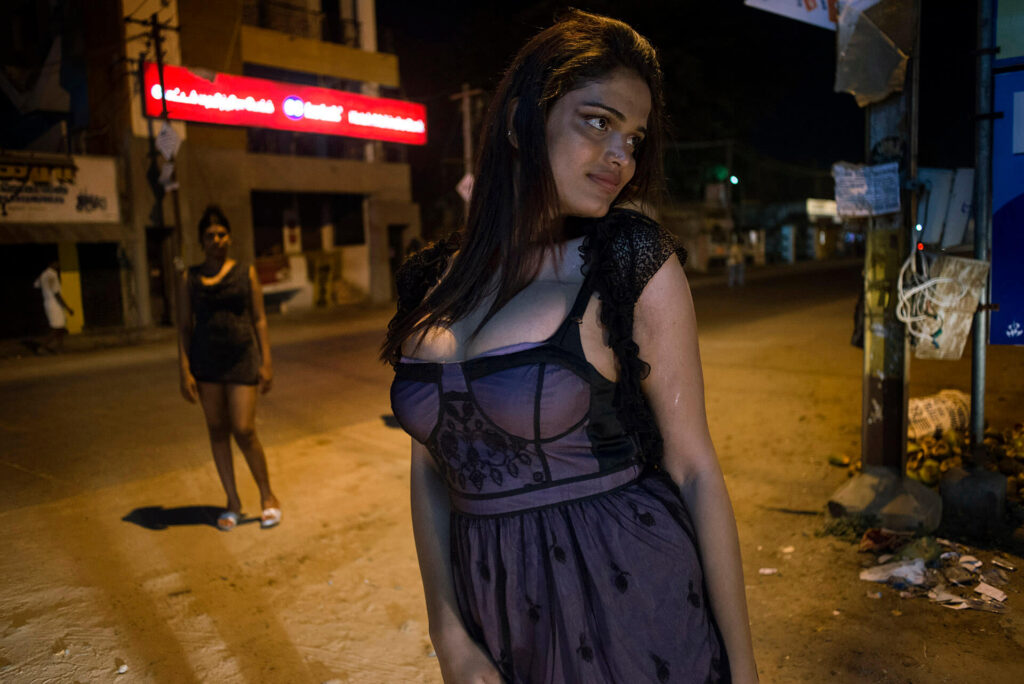
Source: Photo taken by the author, 2014.
Conclusion
This brief essay illustrates how visual analysis can be employed to study the complexity of certain sociocultural practices that are accepted during exceptional events, such as religious festivals, while being condemned outside of them. Although there is now democratic legal recognition of the transgender community in India, the society’s gender norms still push the country into the realm of illiberalism. The photographs included herein reveal the need for a nuanced and contextualized approach of social practices that impact the rights of minorities like the transgender community in India. In Michel Foucault’s words, “Representation—whether in the service of pleasure or of knowledge—was posited as a form of repetition: the theatre of life or the mirror of nature, that was the claim made by all language, its manner of declaring its existence and of formulating its right of speech.”[39] The everyday lives of trans women, from sacred (rituals) to immoral (livelihood), show the importance of participatory and performative actions—a domain that remains understudied by political science.
[1] Sandipto Dasgupta, “‘A Language Which Is Foreign to Us’: Continuities and Anxieties in the Making of the Indian Constitution,” Comparative Studies of South Asia, Africa and the Middle East 34, no. 2 (2014): 228-242, https://doi.org/10.1215/1089201X-2773815.
[2] Alf Hiltebeitel, “Dying before the Mahābhārata War: Martial and Transsexual Bodybuilding for Aravāṉ,” The Journal of Asian Studies 54, no. 2 (1995): 447–73, https://doi.org/10.2307/2058746.
[3] Wendy Doniger, Redeeming the Kamasutra (New York: Oxford University Press, 2016), 114-115.
[4] Govindasamy Agoramoorthy and Minna J. Hsu, “Living on the Societal Edge: India’s Transgender Realities,” Journal of Religion and Health 54, no. 4 (2015): 1451–59, https://doi.org/10.1007/s10943-014-9987-z.
[5] Hiltebeitel, “Dying before the Mahābhārata War,” 464-470.
[6] Venkatesan Chakrapani, Peter Newman, and Ernest Noronha, “Hijras/Transwomen and Sex Work in India: From Marginalization to Social Protection,” in Transgender Sex Work and Society, ed. Larry Nuttbrock (New York: Harrington Park Press, 2018), 214–35.
[7] Thilakavathi Subramanian et al., “‘Mapping and Size Estimation of Hijras and Other Trans-Women in 17 States of India.’ First Level Findings,” International journal of Health Sciences and Research 5, no. 10 (2015): 1-10.
[8] Chakrapani, Newman, and Noronha, “Hijras/Transwomen and Sex Work in India.”
[9] Ibid.
[10] Enze Han and Joseph O’Mahoney, “British Colonialism and the Criminalization of Homosexuality,” Cambridge Review of International Affairs 27, no. 2 (2014): 268–88, https://doi.org/10.1080/09557571.2013.867298.
[11] “Section 377 and Beyond. A New Era for Transgender Equality?” CLPR, 2019, accessed July 29, 2021, https://clpr.org.in/wp-content/uploads/2019/06/Section-377-and-Beyond.pdf.
[12] Reprinted in Han and O’Mahoney, “British Colonialism.”
[13] Reprinted in Han and O’Mahoney, “British Colonialism.”
[14] “India Court Legalises Gay Sex in Landmark Ruling,” BBC, September 6, 2018, https://www.bbc.com/news/world-asia-india-45429664.
[15] Jayna Kothari, “Trans Equality in India. Affirmation of the Right to Self-Determination of Gender,” NUJS Law Review 13, no. 3 (2020), http://nujslawreview.org/wp-content/uploads/2020/09/13-3-Kothari-Trans-Equality-in-India-Affirmation-of-the-Right-to-Self-Determination-of-Gender.pdf.
[16] “The Supreme Court Trans-Formed,” The Hindu, September 15, 2018 (updated September 6, 2019), https://www.thehindu.com/opinion/op-ed/the-supreme-court-trans-formed/article24949441.ece.
[17] “India Court Recognises Transgender People as Third Gender,” BBC News, April 15, 2014, https://www.bbc.com/news/world-asia-india-27031180.
[18] Justin Jos, “Limiting Gender Variance: Critical Reflections on the Transgender Persons Bill,” Economic & Political Weekly LII, no. 4 (2017).
[19] CLPR, “Section 377 and Beyond.”
[20] Menaka Guruswamy, “Justice K.S. Puttaswamy (Ret’d) and Anr v. Union of India and Ors, Writ Petition (Civil) No. 494 of 2012,” The American Journal of International Law 111, no. 4 (2017): 994-1000, https://doi.org/10.1017/ajil.2017.92.
[21] Kothari, “Trans Equality in India.”
[22] Damini Nath, “Transgender Persons Act Comes into Effect,” The Hindu, January 11, 2020, https://www.thehindu.com/news/national/transgender-persons-act-comes-into-effect/article30545336.ece.
[23] Kothari, “Trans Equality in India.”
[24] Judith Butler, Undoing Gender (New York: Routledge, 2004), 75-101.
[25] “Democracy and Pluralism Are Under Assault,” Freedom House, 2020, accessed August 11, 2021, https://freedomhouse.org/report/freedom-world/2020/leaderless-struggle-democracy.
[26] Susan Sontag, On Photography (London: Penguin Books Ltd, 1978).
[27] John Berger, Understanding a Photograph, ed. Geoff Dyer (London: Penguin Books, 2013), 49-50.
[28] Penny Tinkler, Using Photographs in Social and Historical Research (Los Angeles: SAGE, 2013), 124-147; Gillian Rose, Visual Methodologies: An Introduction to Researching with Visual Materials, 4th edition (London: SAGE, 2016).
[29] See, for example, Juliet Corbin and Anselm Strauss, Basics of Qualitative Research (3rd Ed.): Techniques and Procedures for Developing Grounded Theory (Thousand Oaks, CA: SAGE, 2008), https://doi.org/10.4135/9781452230153; Rose, Visual Methodologies.
[30] Gemma Penn, “Semiotic Analysis of Still Images,” in Qualitative Researching with Text, Image and Sound, ed. Martin W. Bauer and George Gaskell (London: SAGE, 2000), 228-45, http://dx.doi.org/10.4135/978184920973.
[31] Roland Bleiker, “Writing Visual Global Politics: In Defence of a Pluralist Approach—A Response to Gabi Schlag, ‘Thinking and Writing Visual Global Politics,’” International Journal of Politics, Culture, and Society 32, no. 1 (2019): 115–23, https://doi.org/10.1007/s10767-018-9299-5.
[32] Michael Edison Hayden and Sami Siva, “After Koovagam, India’s Largest Transgender Carnival,” Pulitzer Center, July 2, 2014, accessed July 29, 2021, https://pulitzercenter.org/stories/after-koovagam-indias-largest-transgender-carnival.
[33] Giorgio Agamben, Homo Sacer: Sovereign Power and Bare Life (Stanford, CA: Stanford University Press, 2004), ch. 5.
[34] Kothari, “Trans Equality in India.”
[35] Chakrapani, Newman, and Noronha, “Hijras/Transwomen and Sex Work in India.”
[36] Elizabeth Dauphinee, “Body,” inVisual Global Politics, ed. Roland Bleiker (New York: Routledge, 2018), 30-34, 34.
[37] Chakrapani, Newman, and Noronha, “Hijras/Transwomen and Sex Work in India.”
[38] Linda Åhäll, “Gender,” inVisual Global Politics, ed. Roland Bleiker (New York: Routledge, 2018), 156.
[39] Michel Foucault, The Order of Things (London: Routledge, 2005), 19.







